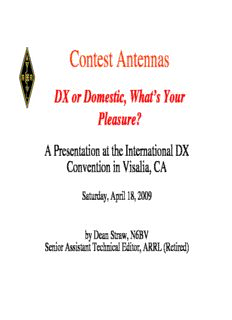
Contest Antennas PDF
Preview Contest Antennas
Contest Antennas DX or Domestic, What’s Your Pleasure? A Presentation at the International DX Convention in Visalia, CA Saturday, April 18, 2009 by Dean Straw, N6BV Senior Assistant Technical Editor, ARRL (Retired) Scientifically Planning a Station There are three elements needed to plan an HF station scientifically: • The range of elevation angles needed. • Antenna performance parameters (modeling). • The effects of local terrain. For Years People Have Said: • For DX contests you need high antennas. • For domestic contests (like Sweepstakes) you need low antennas. • Is this really true? Are domestic and DX contests mutually exclusive? 3 Range of Elevation Angles • More than sixteen years ago I started a detailed study at ARRL HQ on the range of elevation angles needed for communication between various locations around the world. • I used the IONCAP program (now upgraded to VOACAP), along with some proprietary software I wrote. • Recently, I upgraded the statistics using corrected IONCAP loss tables in the latest version of VOACAP, plus more receiver QTHs. Old vs New from VOACAP Old elevation-angle statistics New statistics — subtly (incorrect low-frequency loss showing more emphasis on tables in VOACAP). low angles and less “blank” stats for exotic paths on 80. 5 Even Domestic Contests Get Down Low — to Low Angles, That Is • You would think that domestic US contests involve relatively short distances. • They do — and they don’t. The continental US covers a large area: four time zones. • Let’s look at the paths from Washington, DC — to Boston, to Dallas and then to Seattle. Distances from Washington, DC, Around the USA To Boston: 294 miles To Dallas: 1183 miles To Seattle: 2322 miles Distances from Washington, DC, Around the USA • To Boston: 294 miles — Must be a high- angle path, right? Yes, that’s true. • To Dallas: 1183 miles — Must be a medium- angle path, right? • To Seattle: 2322 miles — Must be a low- angle path, right? S-Meter Calibration for Area Coverage In the following VOAAREA figures, the signal-strength calibration is in dB below 1W (dBW). Here’s how that translates to S-units. Let’s start on 15 meters from Washington, DC. S7 S9 S9 S9+10 Skip Zone 15-meter signals S9 S9+20 10
Description: